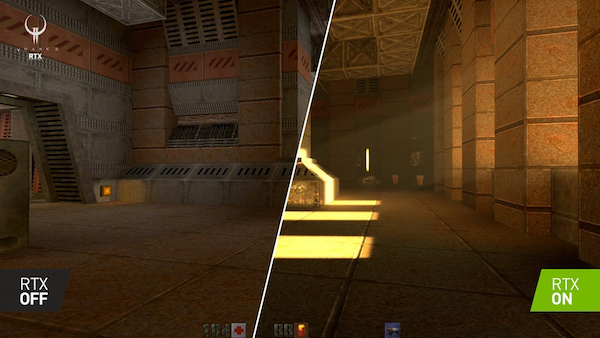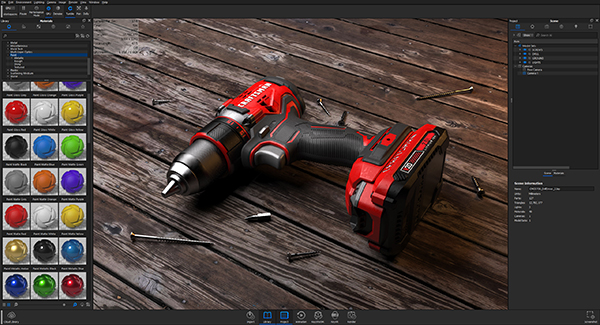Acceleration of Real-Time Rendering in Design
Faster GPUs and real-time raytracing are making it easier for engineers to enable visualization throughout the design process.

At SIGGRAPH 2019, attendees saw the effects of turning on real-time raytracing with RTX in an old game such as Quake. Image courtesy of NVIDIA.
June 12, 2020
Last winter, Luxion released KeyShot 9, the latest version of its CAD-friendly rendering software. The release marked the software’s break from its exclusively CPU-based tradition. For the first time, KeyShot users were able to harness the GPU’s processing cores, with corresponding acceleration in rendering speed.
“Users may toggle between GPU and CPU as needed. GPU ray tracing in KeyShot 9 supports the NVIDIA Maxwell microarchitecture found in the Quadro M6000 or GTX 980 and above with Quadro RTX 4000 or higher recommended,” writes Luxion in its blog post announcing the release.
By then, NVIDIA had released RTX-class GPUs with real-time raytracing. With its timely GPU support, KeyShot brought the same benefit to its users, adding accuracy and sophistication to the rendering results. Luxion’s own KeyShot brand plugins let users interact with its rendering tools directly from familiar design and modeling programs, such as Autodesk Fusion 360, Dassault Systemes SOLIDWORKS, PTC Creo, Onshape, Siemens NX, and Rhino. The coverage expands with third-party plugins that also make KeyShot integration possible with Siemens Solid Edge, Altair’s solidThinking, Alibre, IronCAD, and more titles.
This March, Autodesk announced that VRED, its virtual prototyping software package for automotive design, has added support for RTX-powered real-time raytracing. The feature appears in VRED 2021.
Lukas Fäth, Product Manager for VRED, wrote in a blog post, “We know that the two biggest challenges our customers face are (1) that digital representations need to look and behave as much like the physical product as is possible, and (2) that the methods used to review physical prototypes need to be transferred to the digital world to provide the same benefit … Being able to evaluate digital prototypes in real-time (in motion) has a huge impact on the design and engineering processes in use today. It offers immediate visual feedback to designers and engineers, with optimal interplay between a digital prototype and different variables in the environment, like lights, materials, viewing angles, and shadows.”
Not all renderings are the same. Conventional rendering uses triangulated models of objects to simulate colors, textures, lights, and shadows. By contrast, raytracing uses a method that traces the path of light bounces, resulting in subtle reflections that replicate how light and colors behave on surfaces. It’s a computation-intense process that previously software users had to employ sparingly, reserving it for the most extreme cases. But now that GPUs are becoming a standard part of professional workstations, real-time raytracing also promises to become commonplace among design and modeling software users.
CAD-Integrated Realtime Rendering
Once a feature available only in dedicated rendering programs, real-time rendering is now almost a standard feature in 3D design software. Autodesk Fusion 360, an integrated CAD-CAM-CAE suite, offers as part of its design documentation tools. The drag-and-drop menu allows you to select appropriate materials (steel, plastic, wood, etc.), apply it to the CAD model, and see the result instantaneously.
Dassault Systemes SOLIDWORKS takes a similar approach with its SOLIDWORKS Visualize toolset, available in SOLIDWORKS Professional and Premium editions. Last October, SOLIDWORKS announced, “Visualize 2020 SP0 is the first publicly available production release of SOLIDWORKS Visualize to take full advantage of NVIDIA RTX technology … In our own performance benchmarks, we’ve seen an average of 30% speed improvements with Visualize 2020 over 2019 SP4 on the same RTX hardware! Some scenes show improvements of up to 50%! That’s a remarkable increase in render performance.”
The integration of real-time rendering makes aesthetic judgements part of the design process. Without the need to export the CAD model as STL, OBJ, or STEP model and prepare it for rendering in a separate program, CAD users can instantly invoke real-time rendering to evaluate the effects of a design decision, such as adding a new surface or switching to a new material. It advances the use of digital prototypes to make critical decisions.

Raytraced Rendering
Last winter, Chaos Group announced its renderer V-Ray will begin using the RTX GPU’s real-time raytracing feature. Since V-Ray has direct integration programs and plug-ins to various modeling and animation packages, it further pushes real-time raytracing to a wider modeling community.
“Our RTX support begins today in V-Ray Next for 3ds Max, update 3, V-Ray Next for Maya, update 2, V-Ray Next for SketchUp, update 2 and V-Ray Next for Rhino, update 2, and it’s free to current V-Ray Next for 3ds Max, V-Ray Next for Maya, V-Ray Next for SketchUp and V-Ray Next for Rhino customers. RTX support for our other V-Ray products is in the works,” announced Chaos in a blog post. “With an average speed-up of 40%, we think our RTX support is off to a great start, as it’s already better than what you typically get with a new GPU generation.”
The company is also beta-testing Project Lavina (now in Beta 2), a platform for delivering real-time raytraced 3D environments built as V-Ray scenes. At SIGGRAPH 2019 in Los Angeles, California, the company showed off Project Lavina with a one-billion-polygon KitBash3d city (created by Blizzard Entertainment’s Evan Butler) and a fully interactive walkthrough of a virtual construction site (from 3D artist Kevin Margo’s film).
“Project Lavina can fully ray-trace massive 3D scenes without workarounds or raster graphics. Artists simply drag and drop their V-Ray scenes to explore them immediately in real-time—without the complex setup of a game engine,” said Chaos in its announcement. This positions Project Lavina as a rival to the two leading game engines, Unity and Unreal.
Visualizing detailed 3D scenes is a standard practice in filmmaking and game development, but less so in design and engineering. However, now that the use of simulation to develop autonomous robots and vehicles is increasing, real-time rendering of scenes (of roads and highways or factory interiors, for example) could become more common.
Essential Ingredient in Design
Last year, analyst Jon Peddie Research (JPR) released its report on the “Global Market for Raytracing Software.” The firm estimates the number of 3D rendering software users to be 2.1 million.
“For certain types of design, ray tracing is not desirable but demanded. For example, in the design of optical systems (lens, mirrors, and other components), jewelry design, lighting fixtures, and lamp design. In addition to such physical designs, there is a field of ray tracing for wave and field design in radio and acoustics. In these examples, the design, and resultant images and data must be absolutely physically accurate and photorealistic,” wrote JPR.Resources:
More Dell Coverage

More NVIDIA Coverage
Subscribe to our FREE magazine, FREE email newsletters or both!








